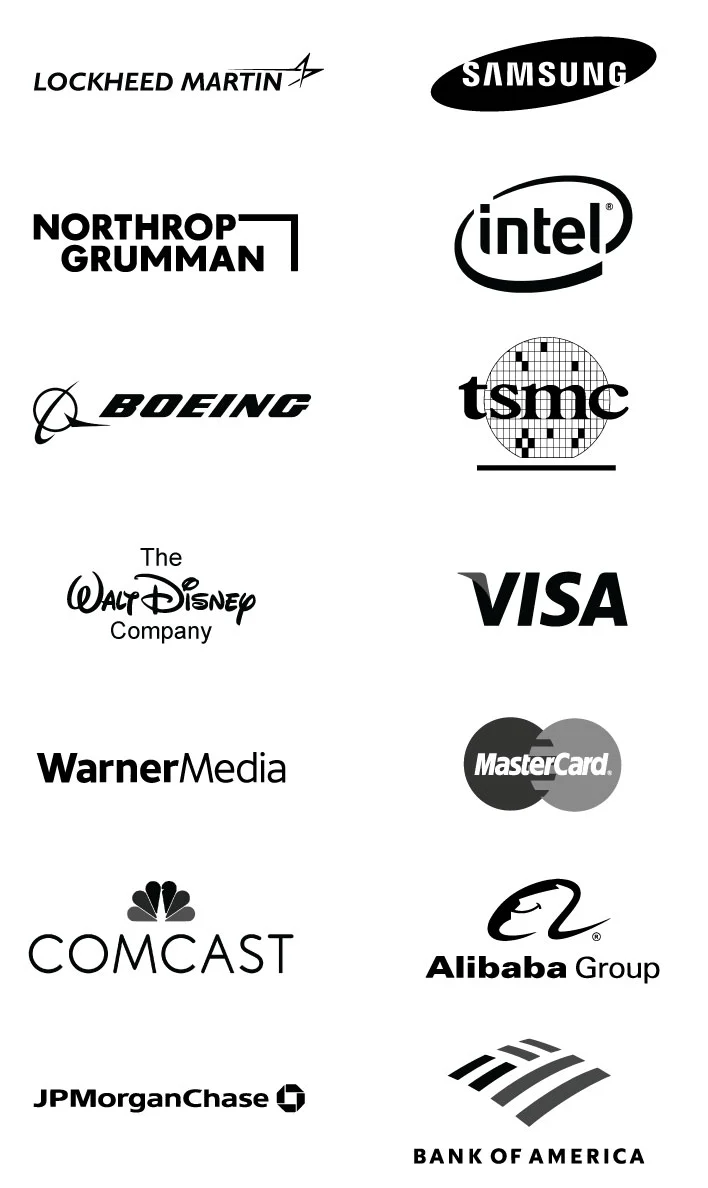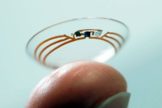
Smart Contact Lenses Market By Procedure (Continuous Glucose Monitoring, Intraocular Pressure Monitoring, And Other Procedures), By End-User (Hospitals, Ophthalmology Clinics, Home Care Settings), By Region And Companies - Industry Segment Outlook, Market Assessment, Competition Scenario, Trends, And Forecast 2023-2032
-
11547
-
Jul 2023
-
162
-
-
This report was compiled by Vishwa Gaul Vishwa is an experienced market research and consulting professional with over 8 years of expertise in the ICT industry, contributing to over 700 reports across telecommunications, software, hardware, and digital solutions. Correspondence Team Lead- ICT Linkedin | Detailed Market research Methodology Our methodology involves a mix of primary research, including interviews with leading mental health experts, and secondary research from reputable medical journals and databases. View Detailed Methodology Page
-
Quick Navigation
Report Overview
Smart Contact Lenses Market size is expected to be worth around USD 6.2 Bn by 2032 from USD 2.2 Bn in 2022, growing at a CAGR of 11.2% during the forecast period from 2023 to 2032.
The smart contact lenses market is a rapidly expanding industry involving the development and incorporation of smart devices into contact lenses. They contain electronic devices and sensors that enable the wearer to monitor their health and improve their vision. They provide various benefits, including monitoring diabetes, tracking body temperature, and monitoring oxygen levels in a patient. This reduces the necessity for invasive procedures and hospital visits.
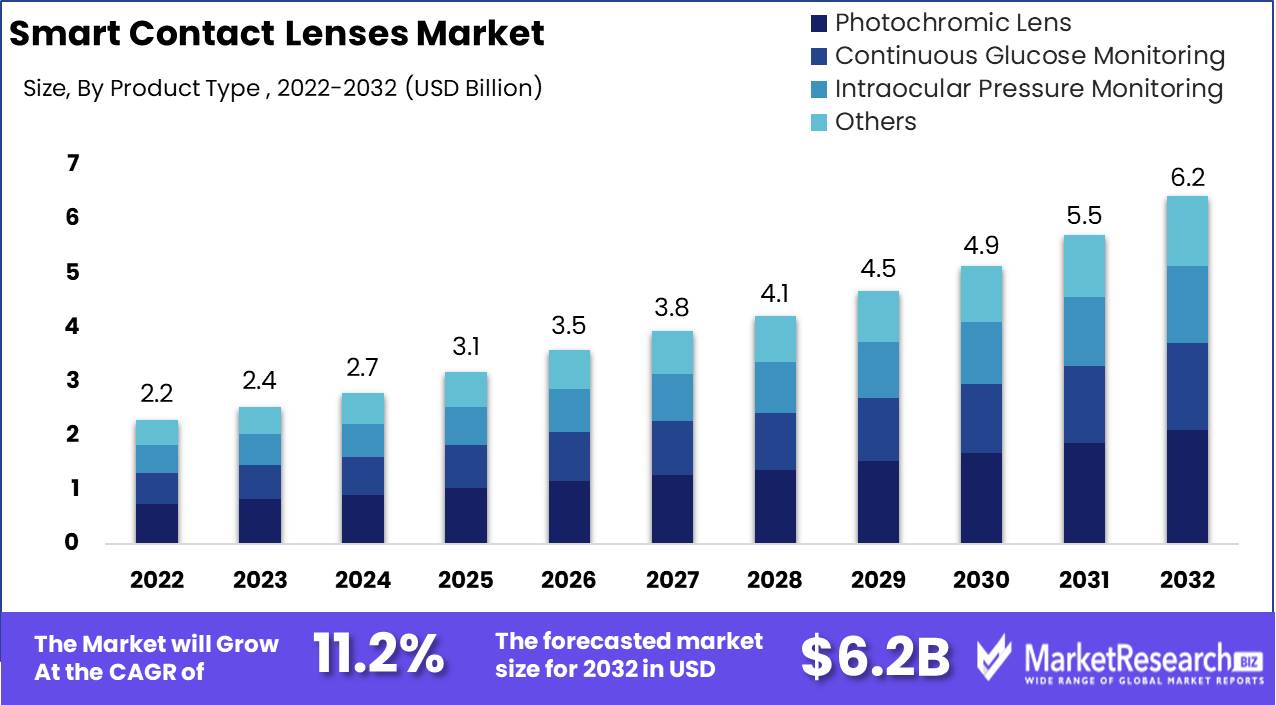
The potential of smart contact lenses Market to aid in diagnosing and treating various medical conditions highlights their significance. They increase the accuracy and sensitivity of health monitoring, allowing for quicker and more precise problem identification. In addition, smart contact lenses offer the benefit of being non-invasive, allowing patients to continue with their daily activities without interruption.
The development of the smart contact lenses Market has resulted in numerous significant innovations, such as the incorporation of sensors that detect blood sugar levels for diabetics, augmented reality technology that improves vision, and micro cameras embedded within the lens that can provide sight to the blind. These innovations have enormous potential, and researchers are continuously developing new capabilities for smart contact lenses.
The smart contact lens market has attracted the interest of numerous industries, which have made investments to advance research and development. Companies such as Google, Novartis, and Samsung have made substantial investments in the development of this technology, resulting in the release of products such as the Google x Verily Smart Contact Lens and the HoloLens smart spectacles that incorporate augmented reality into contact lenses. Such organizations recognize the potential for smart contacts to improve the user experience and quality of life.
Driving factors
Diabetes and related eye problems are becoming more common.
In the past few years, the smart contact lens market has grown a lot, and this is likely to continue in the years to come. One reason for this trend is the growing number of people with diabetes and related eye illnesses. As more people are diagnosed with diabetes, there is a greater need for advanced healthcare technology like the smart contact lenses market to help control these conditions. These lenses might be able to keep track of glucose levels in real-time, which would be very helpful for diabetics.
Getting more people to care for their eyes and vision
The fact that people are becoming more aware of eye health and vision is another thing that is helping the smart contact lens market grow. People are becoming more aware of how important it is to take care of their eyes and are willing to spend money on technology that can help them keep an eye on their health. The rise of this market has also been helped by smart devices getting smarter and more people using wearable devices.
Technological advancements in the field of smart devices
Augmented reality (AR) technology is a new technology that could change the smart contact lens business. AR technology could be added to smart contact lenses so that users could get real-time information about their surroundings or even see virtual information like maps or alerts.
Restraining Factors
High cost of initial investment
Significant resources are required for the creation and manufacture of smart contact lenses. This initial expenditure is one of the primary obstacles to market expansion. The majority of smart contact lenses are prototypes, and the lack of economies of scale increases the price of each pair. This high price makes it difficult to make the technology accessible to a wider audience.
Healthcare providers may be reluctant to prescribe the technology to patients due to its high cost, thereby limiting its market penetration. In order for the market to attain its full potential, companies must find ways to reduce production and pricing costs, thereby making lenses more affordable for end users.
Battery Life Of The Lenses Is Limited
Smart contact lenses are equipped with a number of electronic components that allow them to perform as anticipated. The greatest difficulty is designing lenses that can operate for multiple days on a small battery while providing all of the necessary functions. This is a significant obstacle for manufacturers, as the necessary technology is still in its infancy of development.
In addition, the lenses' functionality is limited by their short battery life; they cannot perform complex duties for extended periods, such as glucose monitoring in diabetic patients. As technology advances, manufacturers must develop batteries that are more efficient and can sustain lens functionality for longer durations.
By Type Analysis
The smart contact lens market is changing. Photochromic Lens Segment smart contact lenses dominate the market due to innovative technologies. Photochromic lenses are versatile because they change colour depending on the light.
The Photochromic Lens Segment of smart contact lenses dominates the market and is predicted to continue to do so. Due to many variables, market experts estimate the segment's growth rate to rise significantly.
The Photochromic Lens Segment of smart contact lenses is driven by economic expansion in developing countries. Advanced medical technology is in demand in emerging economies due to rapid economic growth.
Thus, smart contact lenses, especially photochromic lenses, have grown in these rising economies. With more spare income and better healthcare, citizens in these countries are eager to spend in modern technologies to improve their quality of life.
End-User Analysis
Smart contact lenses market is dominated by Ophthalmology Clinics. Due to its usage in ophthalmology clinics, the segment is predicted to grow the fastest.
Advanced medical technology is in demand in emerging economies due to rapid economic growth. Thus, smart contact lenses have grown in emerging nations, notably in ophthalmology clinics.
These countries' inhabitants are prepared to invest in modern eye health technology due to higher disposable income and greater healthcare access.
Specialised eye care patients have flocked to the Ophthalmology Clinics Segment. Due to its efficacy in treating eye diseases, the segment is growing significantly.
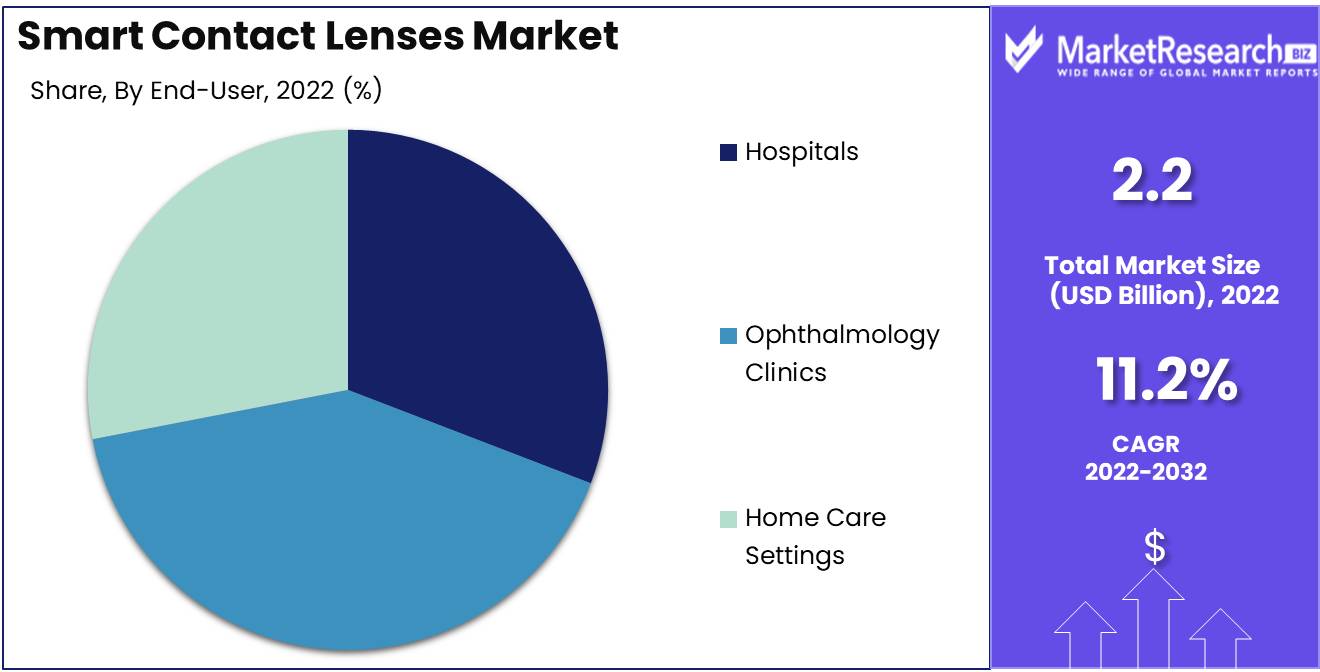
Key Market Segments
By product type
- Photochromic Lens
- Continuous Glucose Monitoring
- Intraocular Pressure Monitoring
- Others (Cholesterol detection, Sodium detection, and Alcohol detection)
By end-user
- Hospitals
- Ophthalmology Clinics
- Home Care Settings
Growth Opportunity
Potential Expansion of the Smart Contact Lenses Market Through Technology, Innovation, and Targeted Services
In a unique way, the smart contact lenses market has the potential to revolutionize healthcare and the way we interact with technology. With significant advancements in wearables and health technology, smart contact lenses offer numerous unrealized benefits and opportunities. By 2025, the global market for smart contact lenses is anticipated to reach $22.6 billion. Expansion into new geographies, the introduction of new features and functionalities, subscription-based service models, targeted solutions for aging populations, and ancillary services to enhance the customer experience are just some of the opportunities that will drive innovation and growth in this industry.
Implementing New Functionality
New capabilities are also essential growth drivers for smart contact lenses. The incorporation of vital diagnostic tools into contact lenses enables users to monitor vital signs and chronic medical conditions in real time. Using smart contact lenses makes the diagnosis, treatment, and monitoring of medical conditions less invasive and more comfortable than traditional methods. This enables patients to manage their health in a nonintrusive manner more effectively.
Latest Trends
Myopia and Other Vision Disorders Are Becoming More Common
Myopia, also known as nearsightedness, has become a prevalent vision condition, particularly among adolescents. According to a study conducted by the National Eye Institute, nearsightedness has increased from 25% in the early 1970s to 42% today. By monitoring changes in the eye's refractive power, smart contact lenses are a promising method for treating myopia and other visual disorders.
Increasing demand for remote monitoring of patients
Because of their ability to monitor patient health parameters in real-time, smart contact lenses have garnered interest from the medical community. In this COVID-19 era, where social distancing is the norm, remote patient monitoring solutions are in high demand. Smart contact lenses can be used to monitor everything from the glucose levels of diabetic patients to the hydration levels of athletes, enabling physicians and clinicians to make more informed decisions regarding patient care.
Increasing Healthcare Investments and Expenditures
Governments and private companies invest significantly in research and development, resulting in a rise in healthcare expenditures and investments worldwide. With the introduction of new products and the globalization of the market, the smart contact lenses market is anticipated to grow significantly in the coming years. Increasing investments in R&D are anticipated to stimulate market growth and innovation, thereby enhancing the capabilities of these lenses.
Regional Analysis
North America has always been a center of entrepreneurship, innovation, and expansion. Over the years, the market size in this region has increased exponentially. According to recent reports, North America dominated the market in 2020
The purpose of this article is to provide readers with a thorough understanding of the market size in North America, the factors that have contributed to its growth, and the market's future prospects.
North America's market size has experienced unprecedented growth over the past decade. This expansion is primarily due to the thriving e-commerce industry. The growth of online shopping has resulted in a rise in the number of businesses operating in the region, leading to an increase in demand for logistics and warehouse services.
Additionally, the growing adoption of digital technologies by businesses has increased the demand for IT services. This has contributed to the expansion of the North American market.
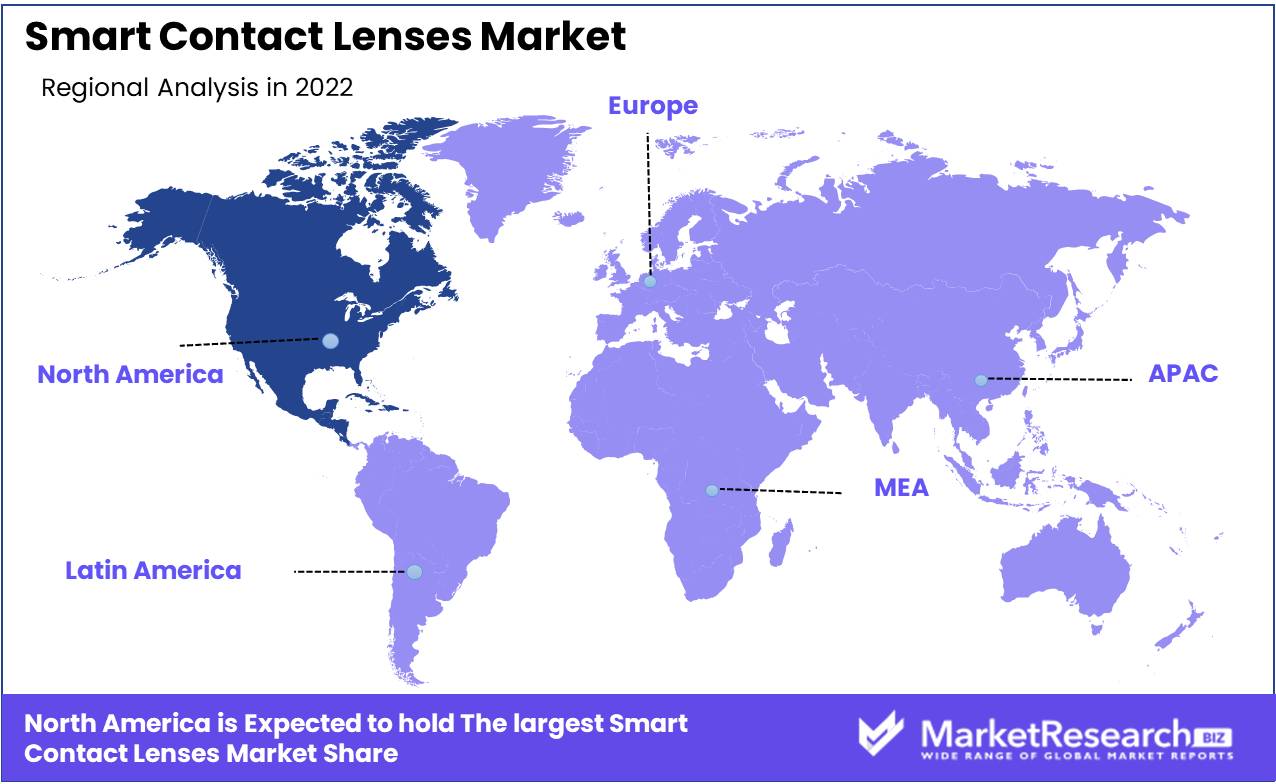
Key Regions and Countries
North America
- US
- Canada
- Mexico
Western Europe
- Germany
- France
- The UK
- Spain
- Italy
- Portugal
- Ireland
- Austria
- Switzerland
- Benelux
- Nordic
- Rest of Western Europe
Eastern Europe
- Russia
- Poland
- The Czech Republic
- Greece
- Rest of Eastern Europe
APAC
- China
- Japan
- South Korea
- India
- Australia & New Zealand
- Indonesia
- Malaysia
- Philippines
- Singapore
- Thailand
- Vietnam
- Rest of APAC
Latin America
- Brazil
- Colombia
- Chile
- Argentina
- Costa Rica
- Rest of Latin America
Middle East & Africa
- Algeria
- Egypt
- Israel
- Kuwait
- Nigeria
- Saudi Arabia
- South Africa
- Turkey
- United Arab Emirates
- Rest of MEA
Key Players Analysis
Numerous prominent competitors have made their mark in the smart contact lenses market, which is rising rapidly. Google has spent over four years developing smart contact lenses. Google's smart contact lens continuously monitors glucose levels for diabetics. Samsung, Sony, Novartis, and J&J are other market leaders.
Samsung's smart contact lenses track reading, TV, and phone use. Sony's unique iris measurement technology can unlock gadgets and control them via eye tracking.
Novartis and J&J are healthcare giants. Novartis is creating a presbyopia-correcting smart contact lens. Johnson & Johnson is developing electronic-correcting smart contact lenses.
Smart contact lenses could revolutionize healthcare by monitoring chronic illnesses like diabetes and correcting vision. These significant players will determine the future of smart contact lenses and how they might improve people's lives as the market grows.
Top Key Players in Smart Contact Lenses Market
- Sony
- Samsung
- Sensimed AG
- Nuravision
- Liner Technologies
- Alcon Vision LLC
- Mojo Vision Inc.
- Innovega Inc.
- Other
Recent Development
- 2021: Mojo Vision, a renowned smart contact lens developer, made headlines in September 2021 when it announced a successful Series B funding round. The company raised a whopping $51 million, cementing its position as one of the leading players in the smart contact lens market.
- In August 2021, researchers at the University of California San Diego made a breakthrough in the development of smart contact lenses. They created a lens that can measure glucose levels in tears, providing an innovative solution for diabetes management.
- 2021: The University of Surrey made a similar progress in June 2021 by announcing the development of a smart contact lens that can monitor intraocular pressure, a key indicator of glaucoma. This development can help prevent vision loss in patients by allowing for early detection and treatment.
- In March 2021, the US Food and Drug Administration (FDA) approved the first smart contact lens for use in the United States. This milestone offers new options for people with ocular conditions, such as presbyopia, that require visual assistance with everyday activities.
Report Scope
Report Features Description Market Value (2022) USD 2.2 Bn Forecast Revenue (2032) USD 6.2 Bn CAGR (2023-2032) 11.2% Base Year for Estimation 2022 Historic Period 2016-2022 Forecast Period 2023-2032 Report Coverage Revenue Forecast, Market Dynamics, COVID-19 Impact, Competitive Landscape, Recent Developments Segments Covered by product type:Continuous Glucose Monitoring, Intraocular Pressure Monitoring, Others (Cholesterol detection, Sodium detection, and Alcohol detection). by end-user: Hospitals, Ophthalmology Clinics, Home Care Settings Regional Analysis North America – The US, Canada, & Mexico; Western Europe – Germany, France, The UK, Spain, Italy, Portugal, Ireland, Austria, Switzerland, Benelux, Nordic, & Rest of Western Europe; Eastern Europe – Russia, Poland, The Czech Republic, Greece, & Rest of Eastern Europe; APAC – China, Japan, South Korea, India, Australia & New Zealand, Indonesia, Malaysia, Philippines, Singapore, Thailand, Vietnam, & Rest of APAC; Latin America – Brazil, Colombia, Chile, Argentina, Costa Rica, & Rest of Latin America; Middle East & Africa – Algeria, Egypt, Israel, Kuwait, Nigeria, Saudi Arabia, South Africa, Turkey, United Arab Emirates, & Rest of MEA Competitive Landscape Google, Sony, Samsung, Sensimed AG, Nuravision, Liner Technologies, Alcon Vision LLC, Mojo Vision Inc., Innovega Inc., Other Customization Scope Customization for segments, region/country-level will be provided. Moreover, additional customization can be done based on the requirements. Purchase Options We have three licenses to opt for: Single User License, Multi-User License (Up to 5 Users), Corporate Use License (Unlimited User and Printable PDF) -
-
- Sensimed AG
- Google Inc.
- Novartis AG
- Samsung Electronics Co., Ltd.
- Innovega Inc.



